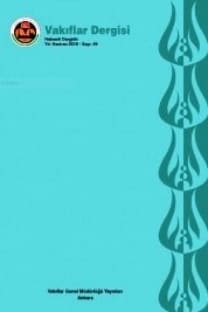Romanya'nın Transilvanya Bölgesi Protestan Kiliselerine Halı Bağışlama Geleneği*
Günümüzde, Romanyanın Transilvanya Bölgesi Protestan kiliselerinde yüzlerce Anadolu köken- li halı bulunmaktadır. 16. yüzyılın ortalarında, Reform Hareketinin Transilvanyaya ulaşmasınınardından kısa süre içinde şiddetlenen Protestan İkona-Kırıcılığı neticesinde kiliselerdeki he- men hemen tüm fresklerin üzeri kapatılmıştır. Transilvanyalı Saksonlar, kiliselerinin sadece kireçboyalı duvar ve sıralardan oluşan mekânlar haline geldiğini görüp bunu değiştirmek istemiş vetam bu noktada bölgede özellikle 15. yüzyılın ikinci yarısından itibaren çok sayıda bulunan Ana- dolu halılarını keşfetmiş olmalıdır. Cemaat üyelerinin soğuk kilise sıralarına daha rahat oturmakve zenginliklerini herkese göstermek amacıyla kullandıkları düşünülen bu halılar, aynı zamandadini bir güdüyle de kiliselere bağışlanmaya başlanmış ve zengin koleksiyonun oluşması sağlan- mıştır. Çalışmada, Transilvanya Protestan kiliselerine gerçekleştirilen halı bağışları incelenmişve sonuç kısmında İslam geleneğindeki camilere halı bağışlama olgusu ile benzerliklerinin olupolmadığı değerlendirilmiştir.
Tradition of Donating Carpets to Protestant Churches of Transylvania Region of Romania
Today, there are hundreds of Anatolian carpets kept in the Transylvanian Protestant Churchesof Romania. After the arrival of Reformation in Transylvania, Protestant-Iconoclasm hadspread across Europe and most of the frescoes in churches were whitewashed. After this,Transylvanians realized, their churches were pale buildings with whitewashed walls and pews.At this point they should have discovered Anatolian carpets which were already in the region,especially from the second half of the 15th century. Parishioners might have bought thesecarpets to lay on the cold pews and also to adorn their pews as a sign of their wealth. Then,they decided to donate these carpets to decorate their churches, with religious motives. Inthis study, the tradition of donating carpets to Transylvanian Protestant churches is examinedand compared with the tradition of donating carpets to mosques in Islam for differences andsimilarities.
___
- Batári, Ferenc (1994). Ottoman Turkish Carpets. Budapeşte. Boz, Levent (2013). Transilvanya Bölgesi Lutherci Mediaş Azize Margaret Kilisesindeki Anadolu Halıları (Hacettepe Üniversitesi Sosyal Bilimler Enstitüsü Yayınlanmamış Yüksek Lisans Tezi), Ankara. Eichhorn, Albert (1968). Kronstadt und der Orientalische Teppich, Forschungen zur Volks und Landes- kunde, XI/I, 72-84. Ionescu, Stefano (2007). Antique Ottoman Rugs in Transylvania, Roma. _________ (2012). Bistriţas Lottos. HALI 172, 34-35. Lajos, Kelemen (1977). Művészettörténeti Tanulmányok, Bükreş. Marshall, Peter (2009). The Reformation A Very Short Introduction. New York: Oxford. Ölçer, Nazan (2009). Venedik-Osmanlı İlişkileri ve Türk Halıları, Osmanlı Döneminde Venedik ve İs- tanbul, 169-171. Pásztor, Emese (2007). Otoman Turkish Carpets, in the Collection of the Budapest Museum of Applied Arts, Budapeşte. Schmutzler, Emil (1933). Altorientalische Teppiche in Siebenbürgen, Leipzig.
- ISSN: 1011-7474
- Başlangıç: 2015
- Yayıncı: Mehmet Kurtoğlu
Sayıdaki Diğer Makaleler
Romanya'nın Transilvanya Bölgesi Protestan Kiliselerine Halı Bağışlama Geleneği*
Restoration of The Bedesten in Trabzon
H. Emre ENGİN, Erkan AYDINTAN, Cengiz TAVŞAN
Aydınoğulları'ndan Osmanlı'ya Bir Batı Anadolu Kenti: Tire'nin Mekânsal Dönüşümü
İstanbul Kilim ve Düz Dokuma Yaygılar Müzesi
Xıx. Yüzyılda Şeyh Şaban Veli Külliyesi
Bir Tarihçinin Kaleminden Osmanlı Dönemi Gördes Halıcılığı Kitabı
Trabzon Ayasofya Camii'nin Mülkiyet Hakkı Üzerine Bir İnceleme
Yakup Emre ÇRUHLU, Osman DEMİR
Tekke Köyü Hacı Abdullah Halife Camisi Duvar Resimleri
Klâsik Osmanlı Sosyal-İktisadî Sistemi ve Vakıflar
Vakıf Kurucusu Olarak Osmanlı Esnafı (18. Yüzyıl İstanbul Örneği)
